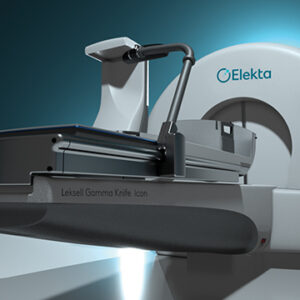Gamma Knife
Key Features of Gamma Knife Treatment
- Precision Targeting:
- The Gamma Knife system employs multiple cobalt-60 sources that emit gamma rays converging on a single point, allowing for very high precision in targeting lesions within the brain.
- Non-invasive Procedure:
- Unlike traditional surgery, Gamma Knife treatment does not require an incision. This reduces recovery time and lowers the risk associated with invasive procedures.
- Single Session Treatment:
- Most patients undergo the procedure in one session lasting from 30 minutes to several hours, depending on the complexity and size of the target area.
Applications
Gamma Knife treatment is primarily used for:
- Brain Tumors:
- Effective for treating malignant and benign tumors located in various parts of the brain (e.g., metastatic tumors).
- Arteriovenous Malformations (AVMs):
- AVMs can be effectively treated by directing targeted radiation at abnormal blood vessel formations.
- Functional Disorders:
- Conditions such as trigeminal neuralgia or certain types of epilepsy can be managed with this technique by interrupting nerve signals.
The Procedure
- Preparation:
- Patients may need imaging studies (MRI or CT scans) prior to treatment to determine tumor size and location accurately.
- Frame Placement or Mask Creation:
- A rigid frame may be attached to the skull under local anesthesia; alternatively, a custom mask can be made for patients who cannot tolerate frame placement.
- Imaging & Planning:
- Detailed imaging studies are used to create a treatment plan that identifies angles and doses required for accurate targeting.
- Radiation Delivery:
- During treatment, patients lie still while radiation beams are directed at specific points in their brain according to pre-determined plans made by specialists.
- Post-treatment Care & Follow-up:
- There’s typically minimal recovery time; most patients can return home shortly after completion.
- Follow-up imaging is done weeks or months later to assess effectiveness based on changes observed over time as tumor growth halts or shrinks gradually post-radiation exposure.
Advantages
- Minimally Invasive Approach: – Reduced risk compared with open surgery along with quicker recovery times allow many individuals greater comfort during healing processes afterward too!
2. High Precision*: – Delivers focused doses while sparing surrounding healthy tissue mitigating potential complications associated using conventional treatments where collateral damage could occur inadvertently resulting often requiring lengthy rehabilitative therapies thereafter leading slower overall improvements seen respectively more progressively achieved instead! 3 *Effectiveness*: – Many studies demonstrate positive outcomes through successful management controlling disease progression without necessitating more aggressive interventions taken unless warranted per clinical context identified confirmed therein individually assessed accordingly each person involved cared throughout!
Limitations & Considerations
1. Not Suitable For All Cases: Some lesions may not respond effectively enough requiring alternative methods utilized sometimes best options available surgically combined alongside standard chemotherapy modalities complementarily working together strategically designed tailored around physician recommendations given personal circumstances faced rather than solely relying upon singular approaches exclusively pursued alone independent thereof entirely!
If you have specific questions about thyroid cancer, its management, or anything related, feel free to ask! We will be pleased to help you with our wide hospital & clinic network all over the Turkiye.

